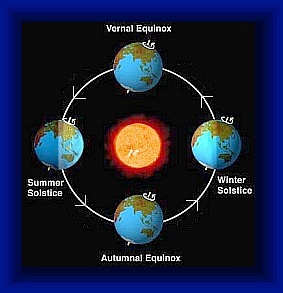|
Winter Solstice
Why did people living in prehistoric times celebrate
the winter solstice? How did they even know what the winter solstice was? And how is this related to the Christmas
tree? Let's first take a look at the Earth's seasons and how the seasonal changes affected the lives of our early ancestors.
The term 'solstice' is derived from two Latin words:
'sol' meaning sun, and 'sistere', meaning to cause to stand still. In ancient times, people watching
the sky thought that, for a few days in the winter, and for a few days in the summer, the Sun appeared to be reaching a fixed
position in the heavens as it rose in the sky.
To understand the difference between Winter and Summer Solstice,
one needs to be familiar with the motion of the Earth, the tilt of the Earth's axis, and how its revolution around the Sun
affects the number of hours of sunlight the Earth receives each day,
The Earth's axis is tilted by about 23.5 degrees. As it travels
in its orbit around the Sun, this tilt determines which areas of the planet receive the most Sun. It's this tilt which
causes our Earth to experience the different seasons.

|
| Earth's Seasons |
During half of the year, the southern hemisphere is tilted more toward
the sun than is the northern hemisphere. During the rest of the year, the other half is more exposed.
At noontime in the Northern Hemisphere the Sun appears high in the
sky during summertime and low in the sky during winter. The time of the year when the sun reaches its maximum elevation occurs
on the day with the greatest number of daylight hours. This is called the summer solstice, and
is typically on June 21st in the Northern Hemisphere -- the first day of summer. The lowest elevation occurs about December
21st and is the winter solstice -- the first day of winter, when the night time hours are maximum.
In ancient times, winter was a very difficult time for people living
in the northern latitudes. The growing season had ended and, in order to survive, people had to live off of the food
they could store, or whatever animals they could hunt. They kept a close eye on the sky and were very much aware
of how high the Sun rose each day.

|
| Stonehenge |
The observation of the seasons was very important to the ancients
-- so important that they built great earthworks which acted as calendars. Stonehenge is a perfect example of this --
particularly that portion of Stonehenge which represents the third phase of its 2000 year construction. The Summer and
winter solstices are clearly marked by the placement of the stones.
As the season approached the winter solstice, people often grew fearful
of the increasing cold and long-lasting darkness. They often wondered if the Sun was going to disappear completely.
But, a few days after the winter solstice people noticed that the
days were beginning to once again lengthen. This was cause for celebration as they knew that spring would be coming
soon. As it turns out, celebrations were often timed for what eventually became December 25th on the Julian
calendar, and then later, the Gregorian calendar.
So, how does all of this relate to the Christmas Tree? Yes,
many of our ancestors celebrated Winter solstice on or about December 25th, but where does the tree fit in? To see how the tradition of bringing a tree into the home first took root, let's take a look at the Yule
Log.
.
.

|

